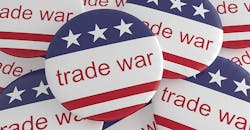When it comes to international trade, the words of Chinese philosopher Sun Tzu seem more apt today than ever: “In the midst of chaos, there is also opportunity.”
For middle-market companies, these are chaotic times indeed. A great deal is in flux. The North American Free Trade Agreement is being recast. The United States has placed tariffs on steel and aluminum, sparking retaliation and trade tensions with everyone from China to the European Union.
In addition, the election of leftist populist Andrés Manuel López Obrador as Mexico’s next president looks certain to shake up regional political dynamics.
Besides political uncertainty and foreign exchange risk, middle-market executives are increasingly anxious about the domestic economic outlook, especially with perennial questions on when the nine-year economic expansion will have run its course.
Reviewing the lessons of history seems unlikely to help predict the future. At such times, Sun Tzu’s “The Art of War” advises us to learn more about our opponent and to become more self-reflective, too. With that in mind, executives should take a hard look at their business to fortify themselves in this uncertain environment. Here are five things I recommend doing:
1. Turn down business: Yes that’s right. Not all business is worth keeping or taking, especially in a turbulent market. Using overtime or adding capacity when certain lines aren’t profitable is actually adding to your risk profile as the market softens. Salespeople get worried about backlog and book sales for sales’ sake, but at what cost? Get granular with your product pricing and look at profitability and cash flow from customers, including their average payment terms, discounts taken, and overhead coverage rate. One-off customers—even long-term customers—may be costing you more than you are aware. Have the courage to say no to the business that isn’t adding significantly to your results. This shows your customers you are serious and may make them willing to make their orders more attractive. Plus, it shows your internal team how serious you are about monitoring costs and profitability in times of uncertainty.
2. Review your supply chain: Executives should re-examine their supply chain against the latest harmonized tariff codes to understand the potential impact on their business. For example, under new aluminum tariffs, companies can no longer claw back tariffs paid once finished goods are exported. Such changes can have a dramatic impact on a business. Companies impacted by tariffs can appeal for an exemption if they cannot source their raw materials elsewhere. However, that process is a gamble that can be tortuously slow, possibly hurting cash flows for a year or longer, and such efforts may ultimately fail. Of roughly 49,000 appeals filed to date since steel and aluminum tariffs went into effect in March, about 16,500 have been processed and about 12,000 have been approved. Sad to say, but some executives might conclude that moving some production overseas is the most sustainable solution.
3. Bolster borrowing capacity: The time to apply for financing is when times are good and you don’t desperately need the money. With interest rates still low but the U.S. Federal Reserve gradually raising rates, there is an extra urgency to boost borrowing capacity now. Nevertheless, bankers tell me that few businesses are applying to increase their borrowing capacity — something they should do now rather than waiting for a possible recession or business slowdown. Having improved borrowing capacity can be the difference between surviving a recession and going under. For example, that extra resource can provide the needed extra cash flow should customers start demanding a 60-day window to pay invoices, rather than 45 days.
4. Review foreign currency exposure: It’s a common fallacy that U.S. firms don’t have FX risk because they only buy and sell in contracts denominated in U.S. dollars. That does not eliminate FX risk in the firm’s supply chain, where even if contracts are dollar-denominated their value can rise and fall with the movement in an FX pairing, significantly impacting cash flows. Lately, for example, the dollar has weakened against the euro but strengthened against China’s yuan. Only by assessing FX risk can a company develop a plan to hedge against currency fluctuations.
5. Build relationships: This is a time for building relationships with state and local economic development offices and becoming active with trade organizations, including chambers of commerce. Beyond lobbying the government for change and letting elected officials understand the real-world impact of trade policy, it can help open up new markets. For example, U.S. Export Assistance Centers are located in more than 100 cities, offering help with exporting issues. Similarly, District Export Councils can help companies develop export strategies for new markets and can offer new contacts and advice.
With so much evolving when it comes to trade, executives cannot afford to be complacent but should plan now for whatever the future might hold. Taking the five steps above will leave any business better positioned to weather possible trouble ahead.
Lou Longo is International Consulting Practice Leader at Plante Moran in Chicago.
